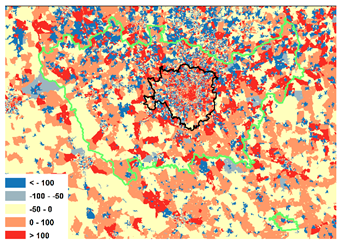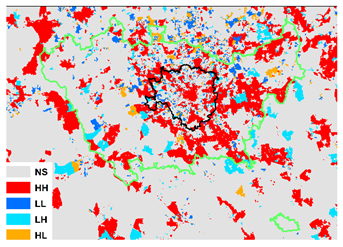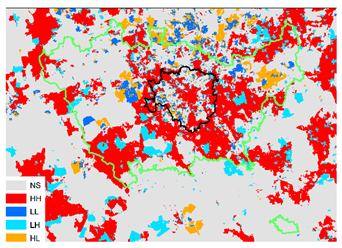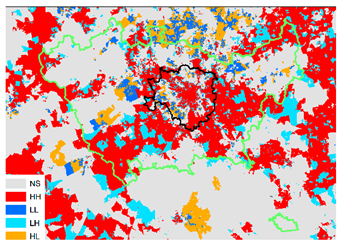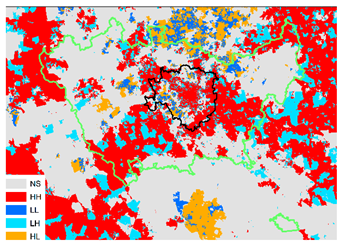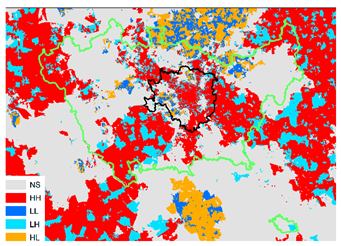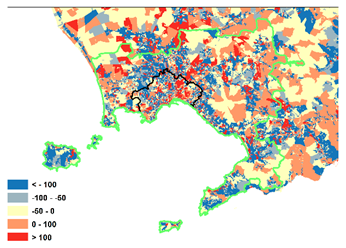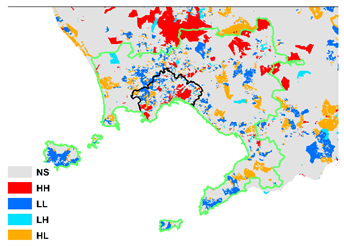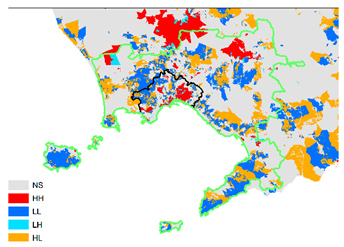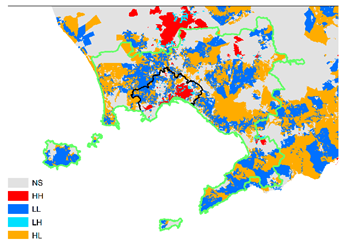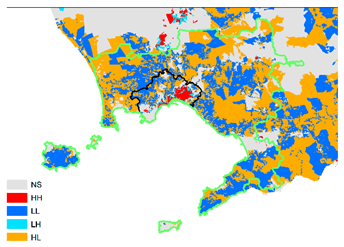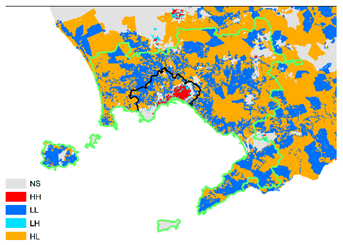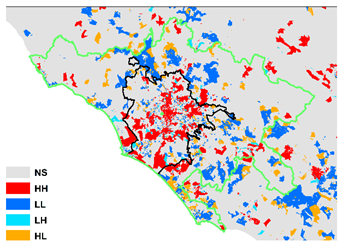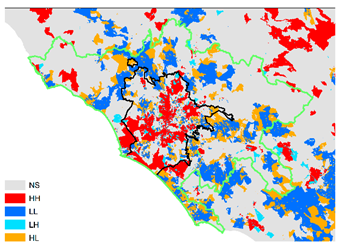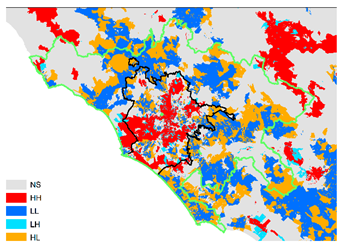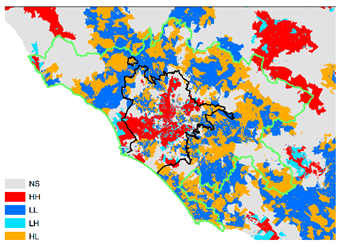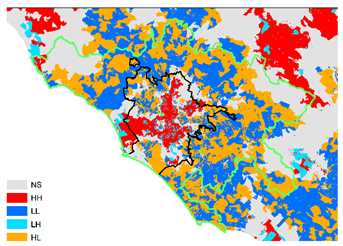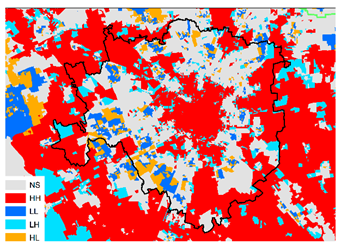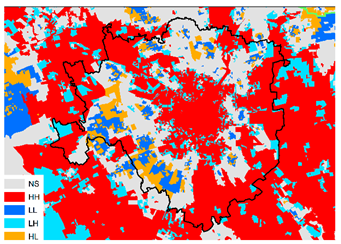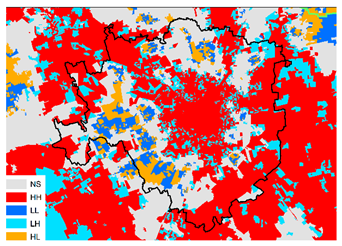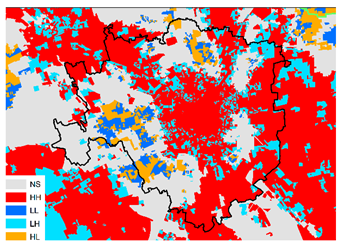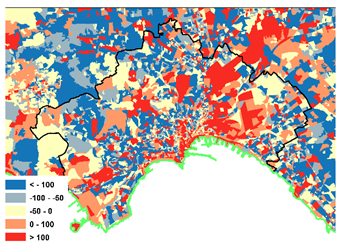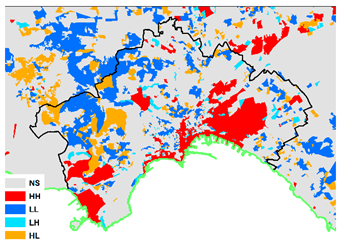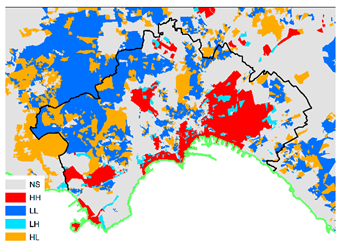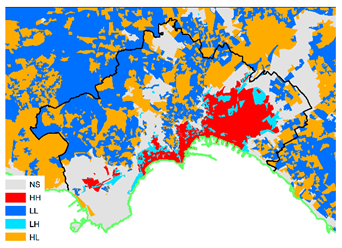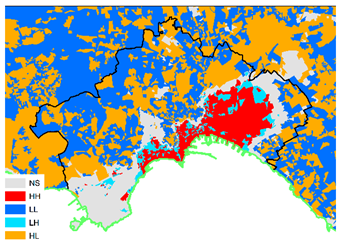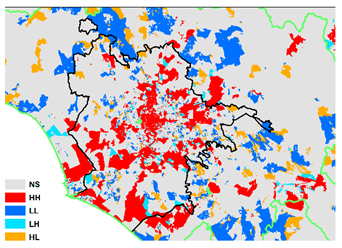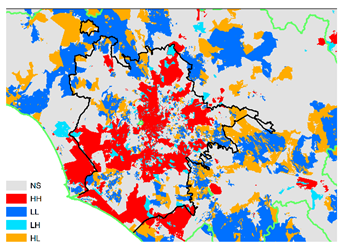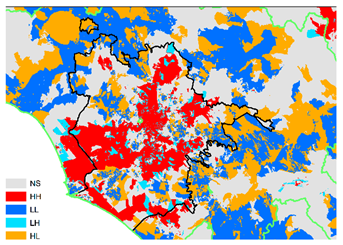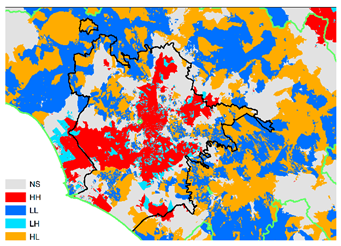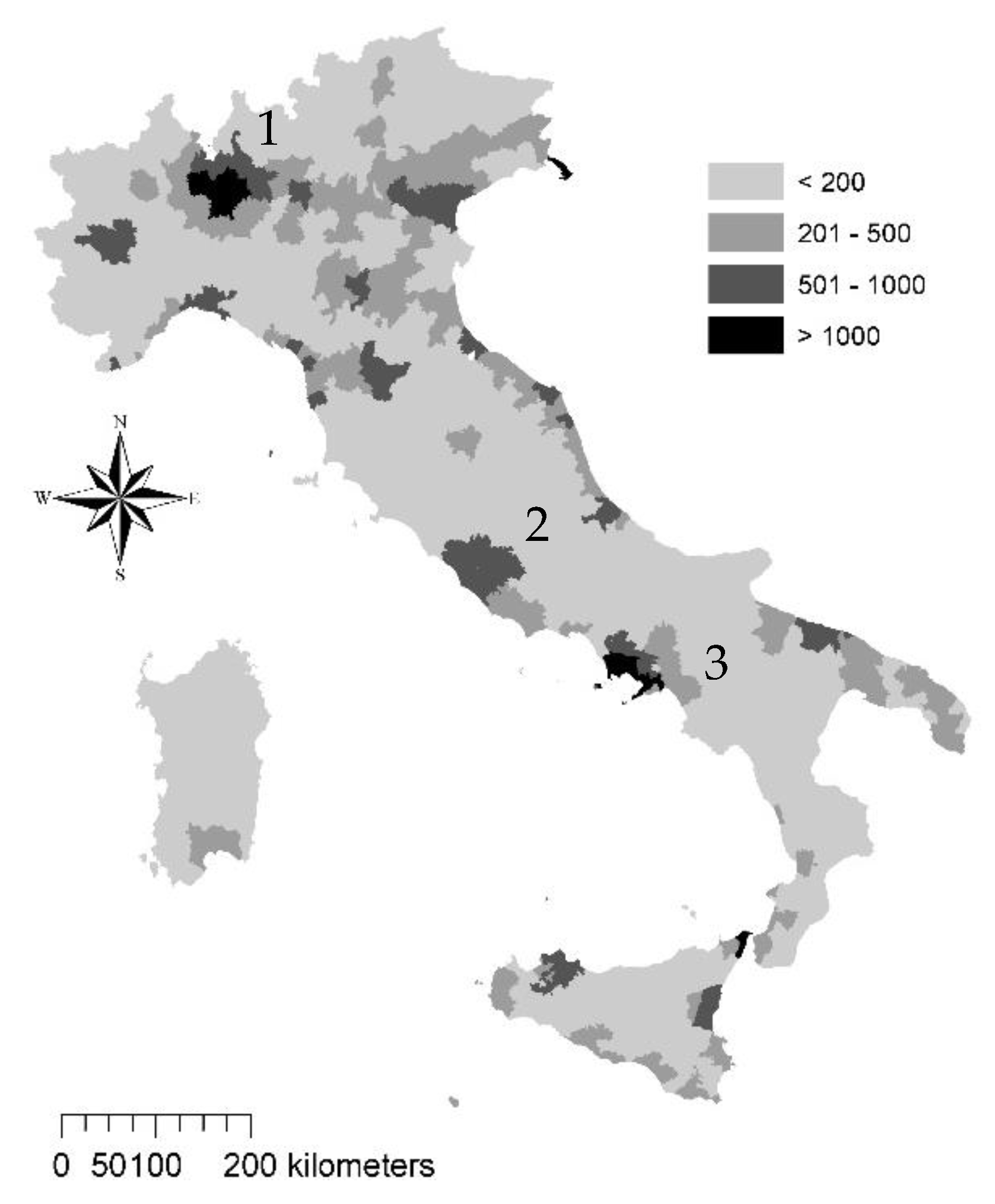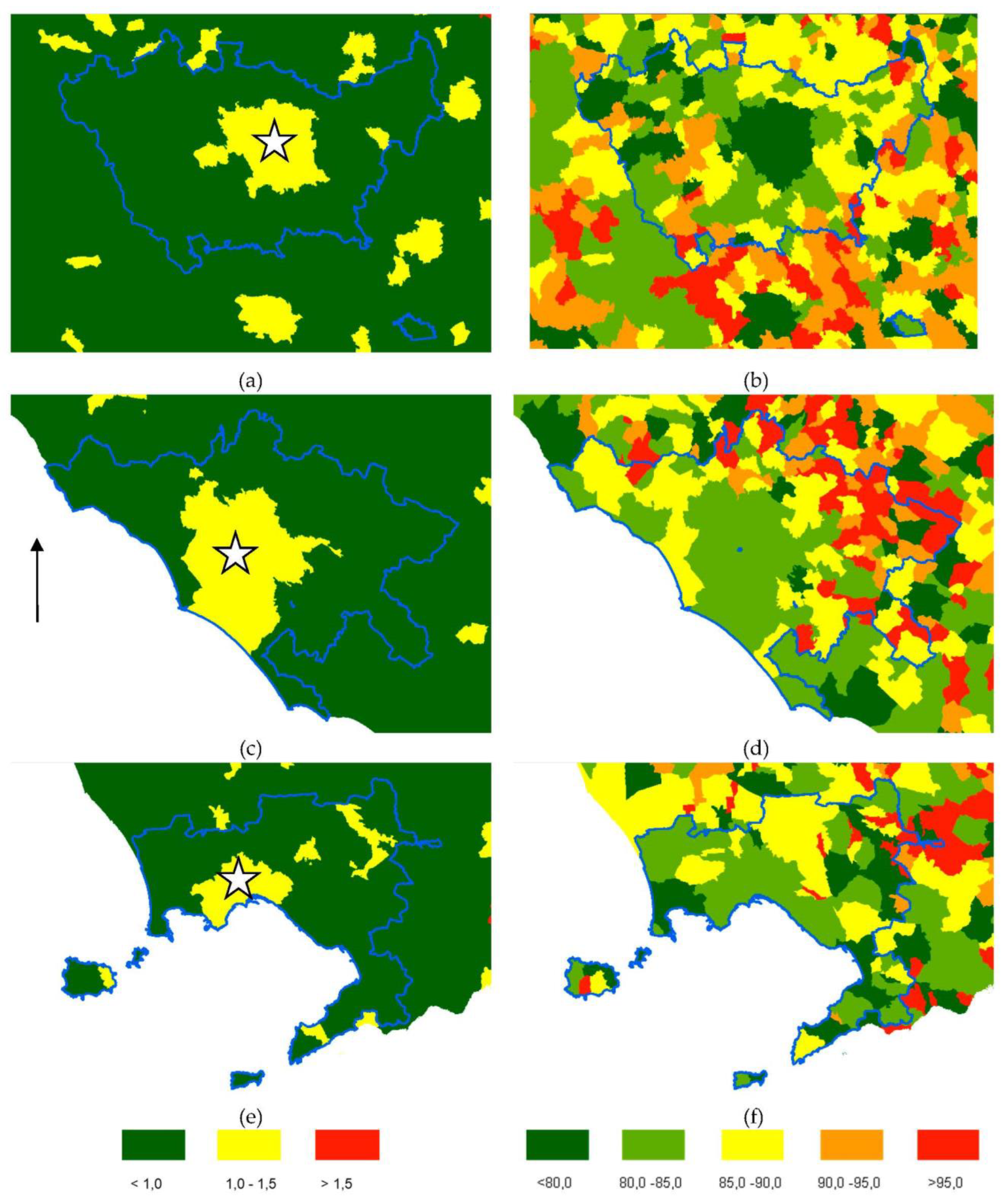1. Introduction
An extensive debate on the physical delimitation of cities from both positive and normative perspectives has arisen in recent decades [
1,
2,
3], and the operational identification of city boundaries and the intrinsic relation with neighboring territories—both towns and villages—have become challenging tasks in official statistics [
4,
5,
6]. Consensus exists on the fact that, while cities exist independently of their administrative boundaries [
7] an accurate assessment of the functional organization of urban agglomerations is intrinsically influenced by the operational definition of its physical borders [
8]. Classical studies in urban economics indicate the spatial concentration of population and activities as a distinctive feature of a given metropolis [
9].
Focusing on the spatial organization of urban centers, Christaller’s central location theory and its generalization at local/urban scales investigated the peripheral dynamics only partially [
10]—sometimes neglecting latent socioeconomic processes at the suburban scale [
11]. Assuming cities as a central location implies a thorough definition and delimitation of peripheral locations [
12]. For instance, if core cities result in economic agglomeration and a concentration of production activities [
13], peripheral locations may reflect the spatial concentration of users and consumers [
14]. At the same time, peripheral districts identified with the physical distance from downtown were sometimes recognized as economically marginal areas [
15]. However, economic marginality is a different concept from the notion of ‘urban periphery’ [
16], because economic backwardness and geographically remoteness from a fixed center coincide only in some cases [
17].
Marginality becomes a statistical issue when choosing relevant indicators and a geographical issue when identifying the appropriate survey scale [
18]. Moving from global to local scales, increasingly diversified concepts of ‘centers‘ and ‘periphery’ were proposed in operational exercises delineating the boundaries of individual cities and neighboring districts [
19,
20,
21]. This can be theoretically difficult when studying the metropolitan dynamics in Europe, a continent of ‘sticky urban boundaries’—following the seminal definition of Cheshire and Magrini [
22]. With this perspective in mind, complex socioeconomic processes, such as residential neighborhoods typical of settlement sprawl, just to mention one example, should be conceptually separated from the latent dynamics of urban marginalization because of a structural lack in attractiveness, e.g., infrastructural shortages [
23,
24,
25].
The definition of a threshold level allowing an objective (and, possibly, automatic) determination of the physical boundaries between central and peripheral locations is a critical example to this way of reasoning [
26]. Some scholars [
27] have circumvented the problem, adopting a spatial analysis, e.g., using an empirical framework based on Local Indicators of Spatial Association (LISA) to identify meaningful clusters that reflect central settlements [
28] In this analysis, LISA was applied to different urban functions resulting in high-density and low-density clusters [
29]. The empirical results of these works suggest that LISA is an appropriate tool assuming the size of urban centers and their distance as the result of the intrinsic spatial organization of metropolitan regions—intended as a multivariate dimension of urban complexity depending on (and resulting in) specific spatial patterns of commuting [
30]. With this perspective in mind, the investigation of peculiar patterns of population distribution over regions reduces to an empirical analysis of commuter flows, basically home-to-work movements [
31].
In the broader perspective of a commuting analysis, the issue of urban marginality and suburban development was debated in recent times from a purely normative (policy and planning) perspective [
32,
33]. In Italy, the establishment of a Parliamentary Commission, whose work supported legislative decisions on spatial planning, was established by a resolution of the Italian Chamber of Deputies in July 2016, with the main task of formulating objective methodologies assessing socioeconomic marginality in central cities and suburbs [
34]. The commission evaluated a number of factors including: (i) urban structure and the social composition of the suburbs; (ii) productive contexts and the related indicators, such as employment rates, unemployment rates (and especially female and youth rates), and undeclared and precarious jobs; (iii) poverty, marginality, and social exclusion; (iv) education and training supply; (v) distribution of infrastructural resources and mobility; (vi) distribution of collective services (schools, training, health, religious, and cultural and sport facilities); and (vii) migrant density and the presence of specialized organizations aimed at cultural mediation and social inclusion [
35].
Notions of ‘centrality’ and ‘peripherality’ were operationalized considering a ratio obtained as the division of the total amount of commuting inflows (number of persons) by the total amount of commuting outflows from/to a given (administrative or physical) spatial unit over a given time interval [
36]. These definitions were presented in an official report to the Italian parliament dated December 2017 and adopted formally in policy exercises regarding urban planning. Peripheral locations were assumed as ‘economically marginal’ areas considering the documented inability of a given place to attract flows of people and services from neighboring locations [
37]. Suburbs were identified as areas with little commuting demand [
38].
Assuming city marginality as a persistent inability to attract incoming commuter flows (in line with the original definition of the Italian Parliamentary Committee, see above), the official statistical system of Italy (headed by the National Statistical Institute, Istat) introduced a summary index assessing social vulnerability and material deprivation [
39]. This index was calculated as a specific elaboration of the commuting matrix considering a municipal-level resolution (Lamonica et al. [
40]). In this perspective, a city’s ability to attract greater inflows than outflows was assumed to indicate a demand for services typical of a central place [
41]. Starting from the experience described above—the activity of the Parliamentary Committee and the related activity of official statistics bringing to the construction of a composite index of territorial marginality with a purely normative meaning—our study introduces the approach underlying the construction of the index to a broader readership and generalizes it to wider background contexts, investigating the roles of spatial scale and geographical coverage [
42]. A thorough discussion of the implications stemming from this methodology was based on an extensive literature review (Chelleri et al. [
43]) and may provide a dynamic and novel interpretation of metropolitan hierarchy.
Because our approach stems from an official statistics perspective, we adopted the census section (i.e., enumeration district) level as the working scale for any operational definition and data elaboration proposed in this study; countries were considered the appropriate investigation coverage [
18]. The use of the enumeration districts—a homogeneous spatial aggregate for both population and activities—allows overcoming the intrinsic (operational) constraints limiting data availability at more aggregate spatial units, e.g., administrative boundaries, such as municipalities, whose heterogeneous geography may negatively impact the estimation of several indicators as they were (and still are) formulated and routinely calculated in official statistics [
44]. The present work is organized in sequential chapters.
Section 2 provides an extensive review of the theoretical and empirical approaches defining ‘centrality’, as opposed to the (basically under investigated) concept of ‘peripherality’.
Section 3 provides an introductory description of the marginality index delineated by the official statistics and expands this framework to an exercise specifically referring to Italy.
Section 4 illustrates the main results of this generalized approach.
Section 5 discusses the relevance and novelty of the empirical results and outlines the main implications for regional policy and urban planning.
Section 6 concludes the work indicating future research targets.
2. Literature Review
Among the logical frameworks proposed so far to interpret urban growth and metropolitan hierarchy, Von Thunen’s isolated city model is one of the most simple approaches, implicitly leaving the relation with other cities in the foreground [
45]. This model allows the identification of urban functions related with the local market and contrasts well-organized centers with the surrounding periphery mainly devoted to the production of primary commodities, including crops and wood [
46]. For instance, following the assumptions of Von Thunen’s model, the United States Bureau of Census introduced the notion of ‘Standard Metropolitan Statistical Areas’ (SMSAs), defined as urban agglomerations with a minimum population size of 200,000 inhabitants and attracting commuters from neighboring territories. In this perspective, Fujita [
1] questioned the spatial organization of urban aggregates as opposed to a dispersed pattern of metropolitan growth.
Assuming cities as externality poles, they were identified as reflecting the decline in transport costs because of the proximity of markets and buyers [
23]. In other words, if the market becomes more concentrated, new places devoted to the production of goods may arise in the city [
2,
47,
48]. The functional specialization of cities implies the progressive development of economic networks and, thus, an increasing pressure on economic agent movements, modifying the spatial pattern of commuting within and between cities [
31,
49,
50]. Considering the physical distance from central cities, [
51] provided a basic theory of metropolitan growth reconnecting economic geography and urban networks, operationally focusing on the number of phones per city compared with the national average of the same variable as a proxy of urban concentration. Additional criteria were identified, for instance, in the number of economic activities or in the synergic presence of scarce services [
36].
Generalizing central location theories to vastly differentiated contexts revealed to be a difficult task because commodity location factors determine (hardly predictable) conditions more (or less) favorable to industrial concentration, under the assumption that industrial location determines a concentration of labor demand [
30]. At the same time, urbanization results in peripheral (settlement) growth and the abandonment of central districts, determining sequential waves of urban expansion and shrinkage [
39]. Especially with rising prices of real estate, the population can be forced to move to suburban locations (e.g., [
52]). In this vein, the Alonso (1968) [
46] model envisages a geographical gradient in property prices extending from urban to rural locations that may be seen as an implicit indicator of centrality (e.g., [
53]).
Marshall (2009) [
54] identified the comparative advantage of central locations in the ability to exploit scale economies. The advantages in proximity locations intended as agglomeration economies concentrated in the Central Business Districts [
55]. At the same time, urban size and centrality strictly depend on historical factors and geomorphological aspects, being in turn a function of both area and population [
56]. To this end, urban centrality was investigated as a result of morphology (e.g., settlement compactness), using refined assessment techniques that assume compact settlements as central settlements as opposed to dispersed settlements typical of the periphery [
35,
42,
57]. Assuming local economic systems as an outcome of the locational choice of businesses [
37], Weber’s model of the optimal location of enterprises provided an additional framework to investigate centrality, because—as it is evident throughout historyresidential centers develop where raw materials are concentrated [
13,
58,
59]. Zipf’s rank-size theory inspired alternative approaches based on a spatially explicit analysis of the potential imbalance between resident population and employees [
60,
61,
62].
While explaining—often in a simplified way—the notion of centrality, urban studies and regional science considered commuting patterns and travel choices as ancillary indicator characteristics of central (or peripheral) locations [
26]. Assuming the complementarity of places, Ullman (1941) [
63] proposed a theory of displacement based on spatial economic differences, considering ‘territorial imbalances’ (identified as the lack of a specific function, such as population or economic activities) as an indicator of centrality (or peripherality). Implying Ullman’s place complementarity [
36], the spatial gap between housing market prices and income levels was therefore seen at the base of intensified commuting patterns between the suburbs and central cities [
26]. In other words, Ullman (1980) [
64] envisages a block city with specialized functions and, consequently, an evident spatial segregation of different urban [
17]. The presence of some services in certain locations of the city implies consumer mobility, e.g., to central locations [
28]).
As a result, the radial consolidation of a network between economic centers of different importance stimulates the formation of ‘edge cities’ [
65]. Interpreting cities as a part of a more complex socioeconomic system implies different (geographical and functional) levels of analysis [
66]. Within this theoretical frame, it is difficult to develop a unique indicator of centrality explaining spatial differences at a very local scale [
10]. For instance, population density, one of the most diffused indicators of urban centrality, failed in the joint description of residential concentration and commuting hotspots [
67], confirming accessibility as a centrality factor, as in the seminal view of Ullman (1941). To this end, commuting represents the demand for cities in the sense understood by Ullman, as the need to reach a place to fulfil a given demand for work or study [
46].
4. Results
Table 2 illustrates the spatial drift of the mean value of the polarization index by enumeration district as the contiguity order increases, assuming Queen matrices of spatial contiguity (from the first to the fifth orders) as representative of the spatial structure of the enumeration districts. The empirical data show how, as the order of contiguity varies, the mean values of the polarization index associated with the HH and HL clusters change as a linear function of the contiguity order. In particular, the average values associated with the central clusters HH decrease linearly with the increase in the contiguity order, while the average values associated with the transitional clusters HL follow the reverse pattern, rising weakly with the increase in the order of contiguity and reaching a plateau with the orders 4 and 5. However, considering the HH and HL clusters together, i.e., assuming a classification of centrality extended to transitional territories, the mean polarization index tends to stabilize around values of 2.5 as the contiguity order increases, with modest differences among contiguity orders. All the other territorial partitions deriving from the classification of the enumeration districts showed particularly stable mean values of the polarization index as the contiguity order varies.
4.1. Spatial Clustering
The enumeration districts classified with an insignificant spatial structure (i.e., unpolarized from the point of view of commuting patterns) have values of the polarization index systematically lower than unity (0.64–0.67), thus indicating a weak drift toward economic marginality (about 65 incoming workers out of 100 outcoming workers, on average). These values resulted to be stable as a function of the contiguity order, indicating that the definition of polarized space deriving from LISA was not influenced by the spatial neighborhood. The enumeration districts classified as ‘peripheral’ (LL clusters) had an average polarization index close to 0.2. This means that, in such locations, the inflow of commuters was systematically lower than the outflow (on average 20 workers entered for 100 workers who left the place), thus reflecting the ‘economic repulsion’ of such territories regardless of the structure of the spatial environment; in other words, the average polarization index remained completely stable as the contiguity order varied. Finally, the transitional enumeration districts classified as ‘intermediate-peripheral’ (LH clusters) showed equally stable mean values of the polarization index that ranged between 0.25 and 0.26, evidencing economically marginal territories where, on average, 25 workers entered out of 100 who left.
Figure 3 illustrates an example of the classification of the Italian territory based on LISA clustering of the polarization index, considering an order of spatial contiguity of the Queen matrix equal to 1. Most of the Italian territory was classified as nonpolarized, in line with the underlying assumptions of the index. These territories coincide with an intermediate economic space, both in mountainous areas and in the most accessible places. On the contrary, the greatest level of polarization was observed in coastal areas and in flat inland areas with greater infrastructural development. Central clusters concentrated in metropolitan areas and basically revealed their fine-scale geography using enumeration districts. Peripheral clusters were more scattered throughout the Italian territory being close to metropolitan areas and functionally linked to central areas. A small number of peripheral clusters, however, were geographically more remote, i.e., belonging to more marginal districts from an economic point of view. This spatial pattern reflects the geographical outcomes deriving from short-range and medium-range mobility patterns.
4.2. Descriptive Statistics of the Polarization Index
The statistical distribution of the enumeration districts (frequency, total population, and land size) is illustrated in
Table 3. The results of the descriptive analysis indicate, as expected, that the number of central areas corresponding with the HH clusters of the neighboring districts (i.e., characterized by systematically high values of the polarization index) was relatively low (33 thousands), more than doubling when moving from the first order to the fifth order Queen contiguity spatial matrix. This pattern was in line with the reduction in the average polarization index shown in
Table 2.
The increase in the polarization index characteristic of the HH clusters was associated with a progressive decrease in the number of enumeration districts classified as HH clusters. Based on these results, it seems not appropriate to select an a priori level of centrality, assuming it as a function of the contiguity order. In the exploratory context characteristic of our approach, a specific level of centrality finely tuned with the geography of the polarization index can be selected or, alternatively, a linear function that links the level of centrality with the contiguity order can be defined, e.g., by comparing different spatial configurations of LISA at varying contiguity orders.
4.3. Geographically Weighted Regression
The results of the GWR indicate a negligible effect of the enumeration district size as a predictor of the polarization index (global adjusted R
2 = 0.05), with the local R
2 and local slope coefficients close to zero (
p > 0.05). These findings suggest the validity of the working hypothesis (i.e., the null impact of the predictor on the dependent variable) and confirm (i) the inexistence (or the nonrelevance) of the MAUP effects at the investigated spatial scale and (ii) the substantial stability of the polarization index across the different typologies of the enumeration districts (e.g., rural vs. urban). An indirect confirmation of this assumption came from the spatial distribution of the standardized local intercepts, indicating spatial heterogeneity irrespective of the predictor’s impact. The spatial distribution of the standardized local intercepts in the three exemplificative landscape scenes (i.e., the metropolitan regions of Milan, Rome, and Naples—the three largest cities in Italy) are illustrated in
Figure 4. These maps delineate positive and significant values of the local intercept in correspondence with the three cities (Milan, Rome, and Naples), indirectly delineating central locations irrespective of the size of the enumeration districts and confirming the spatial stability and internal coherence of the polarization index.
5. Discussion
In recent times, the notion of central locations was broadly debated under different disciplinary perspectives—from urban geography and spatial planning to regional economics and rural sociology—often becoming a cross-cutting issue in between research and policy [
36]. The consensus is still limited on the operational delimitation of cities and metropolitan regions [
30]. More importantly, there is a different definition of the administrative boundaries of a city and its effective integration into a broader area. Intensively urbanized areas may transcend the administrative boundaries and should be considered as individual cities despite their administrative/governance settings [
39]. The operational delimitation of centers and suburbs that takes part in (more or less) articulated city networks at different spatial scales was regarded as another complex task [
42].
Intended as central locations, places that are most successful in attracting people require transportation infrastructure and services to meet the expanding demand of the resident population [
46]. Following this rationale, the locations from which people leave daily moving to work are assumed as urban centralities [
13]. There are several strands of literature dealing with urban centrality, the first focusing on the physical definition and delimitation of central locations and the second addressing the phenomenology and manifestation of negative and positive (economic) externalities [
32]. In this regard, the main issues examined in the recent literature concern transport efficiency [
89], pollution [
90], and energy efficiency [
91].
Different methodologies delineating the central and peripheral areas are the result of vastly different analysis solutions investigating the presence of services and the extent of market areas, basically referring to the Christaller and Losch theories of the spatial localization of industries [
41]. A generalization of these approaches allows a refined analysis of the complex system of relationships among urban centers, giving room to an operational discrimination of monocentric or polycentric models reflecting regional settlement structures or the characteristics of specific local development paths [
18]. Accordingly, the position (or status) of a central location in a given urban network is a function of the physical distance or, more generally, depends on the spatial structure of the neighbors [
26].The identification of different settlement types thus implies the estimation of a metric discriminating central from peripheral locations (and, possibly, the intermediate space in between) as a function of physical distance or the intrinsic spatial structure [
92].
In this line of thinking, the present work investigated commuting patterns at a submunicipal level (enumeration district) providing a novel (functional) approach to centrality and periphery [
37], being inspired by an official statistics experience (held by the Italian National Statistical Institute, Istat) that responded to a normative design and pressing demand for territorial indicators. Considering commuting patterns, this analysis indirectly focuses on patterns and processes of local development [
21]. To address such issues, our approach runs a spatial clustering of a polarization index quantifying home-to-work daily travels [
92]. The procedure delineates submunicipal (homogeneous) areas (bigger than enumeration districts) that are considered sinks (centers) or sources (peripheries) of commuter flows [
31].
Taken together, these results demonstrate how the choice of the spatial neighborhood (contiguity order) did not affect the functional classification of a given territory deriving from the analysis of LISA spatial clusters. This is always true in our data with the sole exception of central locations (corresponding with HH clusters) and, in part, of ‘transitional’ central–intermediate locations (HL clusters). The identification of these specific territorial aggregations (HH and HL clusters) depends on the contiguity order chosen within the spatial matrix adopted for computation [
52]). Higher contiguity orders include districts with a low average level of centrality and, conversely, delineate extended central areas. The approach proposed in this work, therefore, highlights how the definition of peripheral, peripheral in transition, and nonpolarized territories is not influenced by the spatial neighborhood and therefore does not depend on the function associated with the geographical matrix used in the LISA analysis [
80].
These findings indirectly document the internal stability of the territorial partition and the reliability of the polarization index, confirming the goodness of representation and the internal coherence of the chosen observation scale [
93]. On the contrary, the level of centrality seems to depend on the structure of the spatial environment, reflecting a greater polarization associated with territorial [
26]. Therefore, the identification of central areas needs to fix a priori an average level of centrality or, alternatively, to study the variability of this measure as a function of different spatial structures [
23], as proposed in this work. These results suggest the importance of modeling complex indicators of centrality as a function of both their dependence on the global spatial scale and on the local structure of the spatial neighborhood [
29].
The appropriateness of using commuter flows as a basic indicator of spatial polarization that reflects both central and peripheral locations is finally documented in a vast number of earlier studies in the field of official statistics—only partly referring to the central location theory [
94]. Commuting was widely investigated to identify socioeconomic processes oriented along (and influenced by) the center–periphery gradient [
95]. In an attempt to delineate Functional Urban Areas (FUAs) taken as a relevant spatial domain, peripheral districts of high-density clusters were identified on the basis of the percent share of workers commuting into this district of the total commuters [
96,
97,
98]. Core districts were identified as a cluster of neighbor spatial partitions with population densities above 1500 inhabitants [
99,
100,
101]. The definitions of Inland Areas operationally adopted in official statistics (and variably developed by European governments as a tool for defining central and marginal areas as a function of accessibility) follow the same rationale [
12,
102,
103].
For instance, the operational definition of travel to work areas, or local labor systems—an important spatial aggregate in official statistics—also derived from these assumptions and practical issues [
44]. One of the first empirical applications to identify local labor systems in Italy dated back to the 1980s when, likely for the first time in continental Europe—apart from the exception of the United Kingdom—they were derived from a commuting matrix using microdata from population censuses [
96,
104,
105]. This exercise also identified core cities together with the related urban hierarchy at a broader spatial scale [
35]. Core cities were assumed as the center of human activities, a development node distinctive from the surrounding periphery [
16]. Taken as a dominant factor in economic development [
41], accessibility and, consequently, commuting patterns thus became a key to operationally define functional areas [
38].
